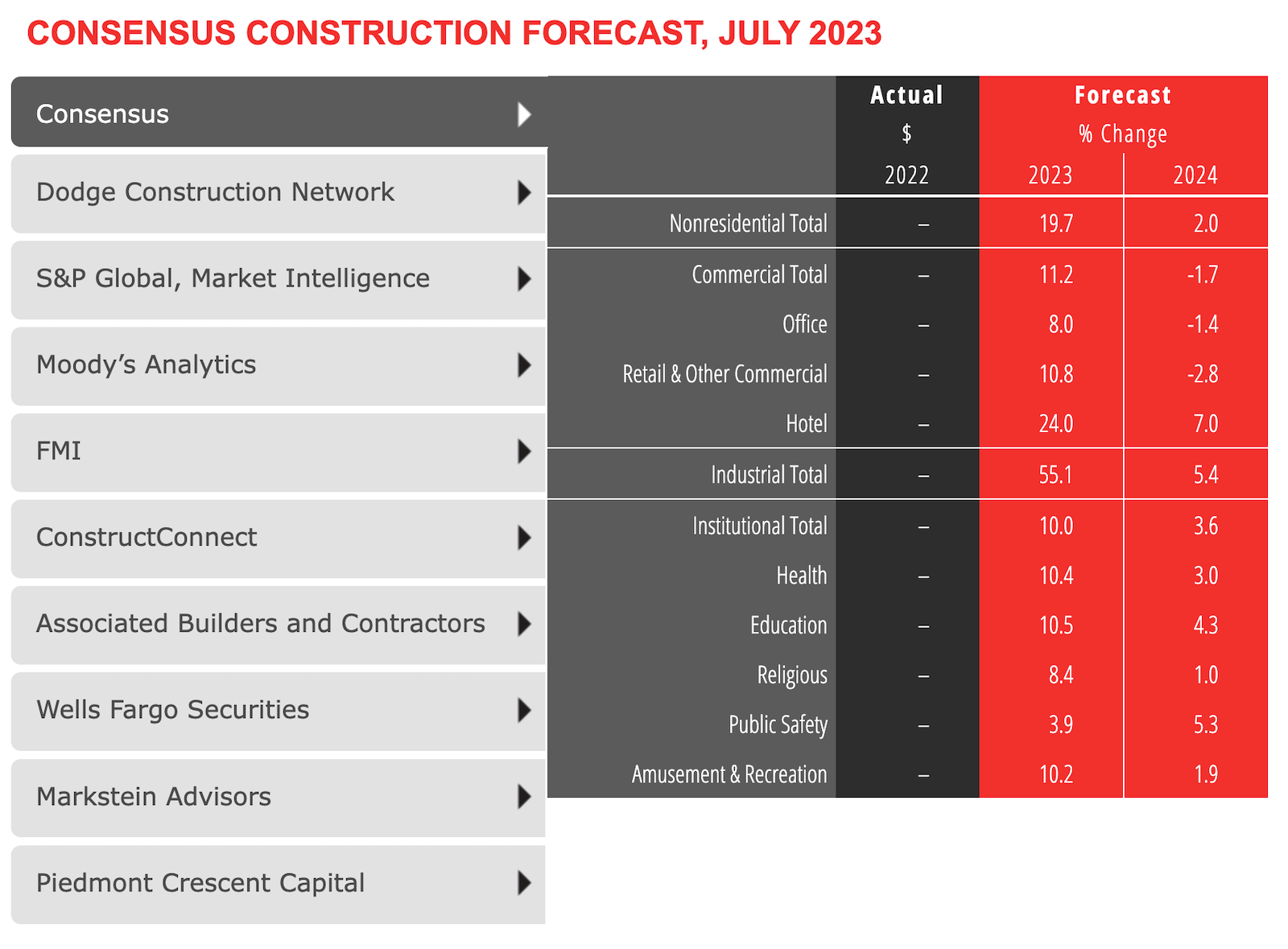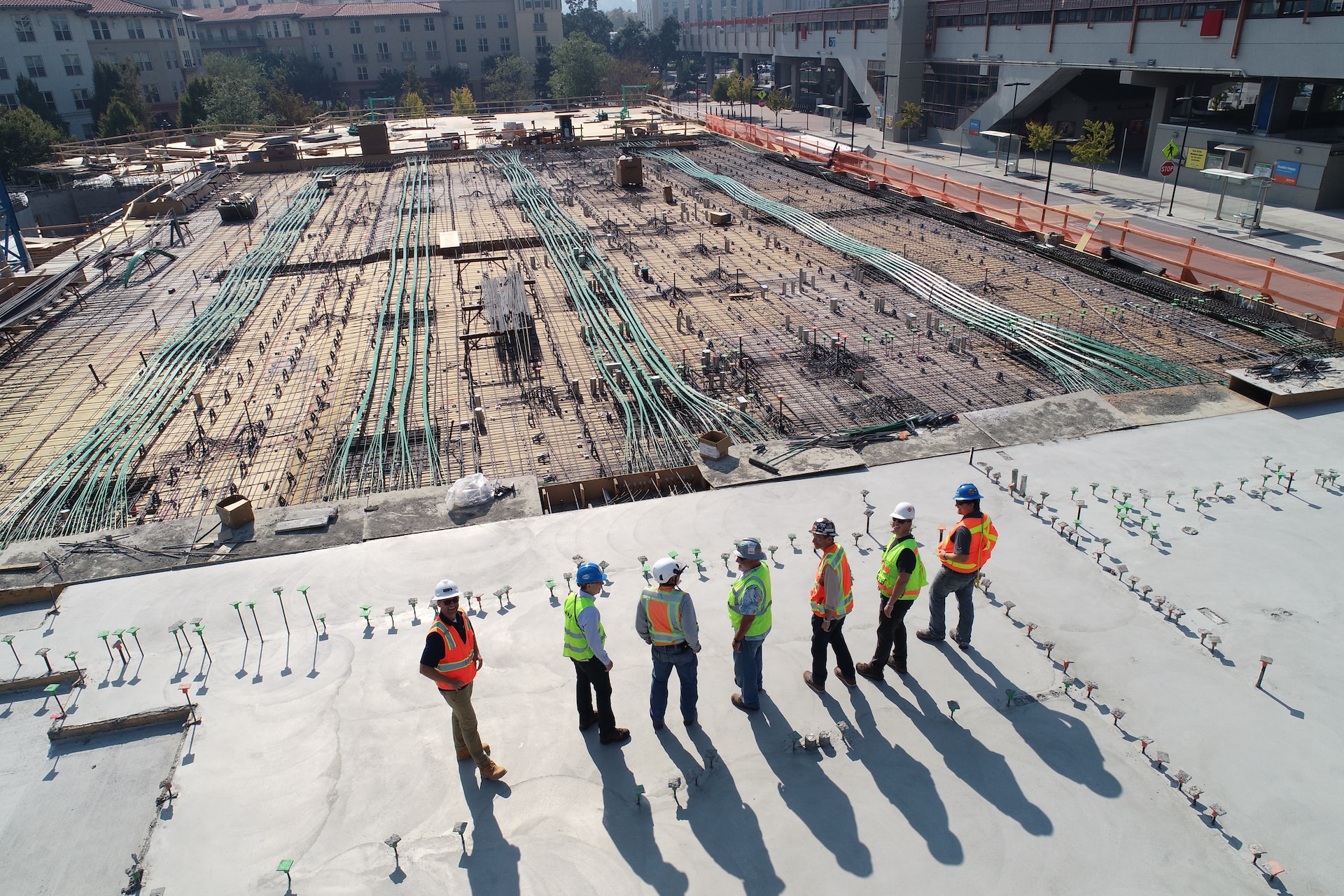Following a 19.7% surge in spending for commercial, institutional, and industrial buildings in 2023, leading construction industry economists expect spending growth to come back to earth in 2024, according to the July 2023 AIA Consensus Construction Forecast Panel.
The twice-yearly Consensus Construction report aggregates building construction spending forecasts from nine leading economists:
- Richard Branch, Dodge Construction Network
- Scott Hazelton, S&P Global
- Steven Shields, Moody's Analytics
- Brian Strawberry, FMI
- Alex Carrick, ConstructConnect
- Anirban Basu, Associated Builders and Contractors
- Charles Dougherty, Wells Fargo Securities
- Bernard Markstein, Markstein Advisors
- Mark Vitner, Piedmont Crescent Capital
All nine economists are in agreement on a 2024 spending-growth slowdown. Two economists are calling for a contraction in spending (Wells Fargo, -1.0%; Piedmont Crescent Capital, -4.7%). ABC's Anirban Basu is the most bullish on 2024, predicting a 7.7% increase in overall building spending.
"The first half of this year has seen gains in construction spending on nonresidential buildings approaching 20%. However, this scorching growth rate is expected to moderate a bit moving into the third and fourth quarters," wrote AIA Chief Economist Kermit Baker, Hon. AIA, in the report. "Even with the easing in supply chain issues and the improved pricing of many construction materials and products, elevated interest rates, more restrictive lending on the part of banks, nervousness over the direction of the economy, and construction labor constraints are expected to slow the pace of growth."
Bright spots for the remainder of 2023 and 2024 include:
- Healthcare, driven by the aging baby boom population
- Manufacturing/distribution, thanks to the post-Covid reshoring of production resulting from supply chain issues during the pandemic
- Hotels, with leisure travel returning to normal following the pandemic
- Education, as school districts and higher education institutions play catch-up on projects in the wake of Covid.
"There are emerging concerns that outsourcing the manufacturing of high-tech products leaves our economy and national defense more vulnerable," Baker wrote. "The $280 billion in funding provided by the 2022 federal CHIPS and Science Act is designed to advance domestic research and manufacturing of semiconductors in the United States. These funds will boost spending for these facilities for much of the coming decade."
View the full AIA Consensus Construction Forecast Panel report, including an interactive table with market forecasts from all nine economists.

Related Stories
Market Data | Feb 6, 2023
Nonresidential construction spending dips 0.5% in December 2022
National nonresidential construction spending decreased by 0.5% in December, according to an Associated Builders and Contractors analysis of data published today by the U.S. Census Bureau. On a seasonally adjusted annualized basis, nonresidential spending totaled $943.5 billion for the month.
Architects | Jan 23, 2023
PSMJ report: The fed’s wrecking ball is hitting the private construction sector
Inflation may be starting to show some signs of cooling, but the Fed isn’t backing down anytime soon and the impact is becoming more noticeable in the architecture, engineering, and construction (A/E/C) space. The overall A/E/C outlook continues a downward trend and this is driven largely by the freefall happening in key private-sector markets.
Hotel Facilities | Jan 23, 2023
U.S. hotel construction pipeline up 14% to close out 2022
At the end of 2022’s fourth quarter, the U.S. construction pipeline was up 14% by projects and 12% by rooms year-over-year, according to Lodging Econometrics.
Products and Materials | Jan 18, 2023
Is inflation easing? Construction input prices drop 2.7% in December 2022
Softwood lumber and steel mill products saw the biggest decline among building construction materials, according to the latest U.S. Bureau of Labor Statistics’ Producer Price Index.
Market Data | Jan 10, 2023
Construction backlogs at highest level since Q2 2019, says ABC
Associated Builders and Contractors reports today that its Construction Backlog Indicator remained unchanged at 9.2 months in December 2022, according to an ABC member survey conducted Dec. 20, 2022, to Jan. 5, 2023. The reading is one month higher than in December 2021.
Market Data | Jan 6, 2023
Nonresidential construction spending rises in November 2022
Spending on nonresidential construction work in the U.S. was up 0.9% in November versus the previous month, and 11.8% versus the previous year, according to the U.S. Census Bureau.
Industry Research | Dec 28, 2022
Following a strong year, design and construction firms view 2023 cautiously
The economy and inflation are the biggest concerns for U.S. architecture, construction, and engineering firms in 2023, according to a recent survey of AEC professionals by the editors of Building Design+Construction.
Self-Storage Facilities | Dec 16, 2022
Self-storage development booms in high multifamily construction areas
A 2022 RentCafe analysis finds that self-storage units swelled in conjunction with metros’ growth in apartment complexes.
Market Data | Dec 13, 2022
Contractors' backlog of work reaches three-year high
U.S. construction firms have, on average, 9.2 months of work in the pipeline, according to ABC's latest Construction Backlog Indicator.
Contractors | Dec 6, 2022
Slow payments cost the construction industry $208 billion in 2022
The cost of floating payments for wages and invoices represents $208 billion in excess cost to the construction industry, a 53% increase from 2021, according to a survey by Rabbet, a provider of construction finance software.

















